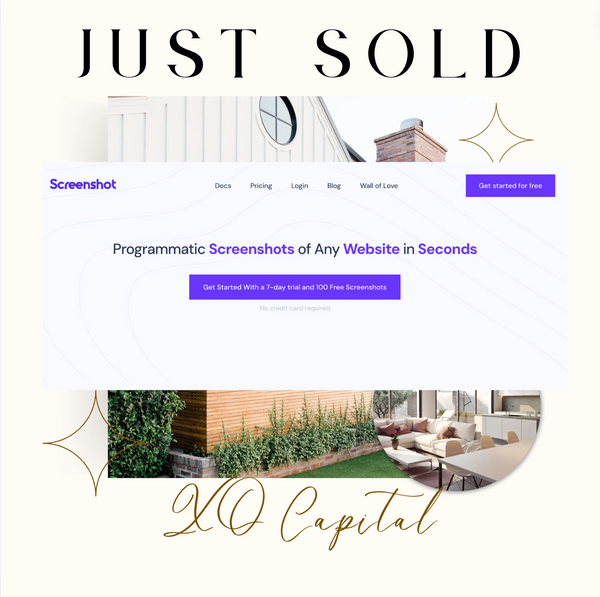Sale #3

We sold Workclout. It was the one company in the portfolio that no longer fit with our relatively new focus on PLG companies. That's not to say we wouldn't acquire a non-plg type company in the future but it would either have to be:
- Bigger
- After we reach profitability with the existing portfolio.
If the product made multiple 6 figures in revenue, we'd be able to afford to hire people. As it stands, buying a non-plg type company with our shared services model does not work well. It ends up taking up the majority of Danny's time doing sales and hand holding customers. It also implies a larger product, which also is awkward when one of the port co's takes up too much engineering time. With a portfolio, there's always a fire, but if one product takes priority over another, there could be a loss of trust from customers and a slow march towards death for the product. This would perhaps not be the case if we had more outliers in the portfolio, but to date, our revenue is split relatively evenly across the portfolio. The exception here is colddm which is growing fast but at around ~$2k MRR (already 10x from where we bought it, but 2-3x smaller than the rest).
How did the sale happen?
on Acquire.com
But first, we tried a broker. We had a lot of interesting conversations with companies we would never have been able to get in front of. It was a cool experience, but we paid a chunk of cash for it, and ultimately they all went cold. We then listed it on acquire.com and got a few offers at modest valuations and took the one we felt had the highest probability of closing. It was not the highest dollar amount.
I'm not anti-broker, I think for a sufficiently large deal, having a broker is still the way to go, but acquire.com is a lovely backstop.
So why sell?
Our number one reason was that it didn't fit with the rest of the portfolio. For better or for worse, we're focused on getting profitable. We're close, but not quite there yet and will likely need to acquire our way to profitability.
Selling is also a great way to compound cash. We bought it, held it for a year+, then sold it. We're now able to book in a decent win and re-deploy that capital on something that fits our model better. It found a great forever home with a group active in the manufacturing space and they are much better suited to take the company to the next level.
Product vs Sales Led Growth
If you don't know what product led growth is, think freemium, or some site where you can just sign up without talking to anyone. The products themselves are usually simple enough for you to figure out on your own without much help from support or perhaps with the use of some youtube videos. You generally use content or paid ads to fill the top of funnel, bringing people to the front door. You then try to measure and optimize conversions from website visitor, to new user, to converted user, to (eventually) a churned user. Every step in the journey is meant to fit together like a swiss watch and when it ticks, it's a beautiful thing, but tuning every step in just the right way is a long and arduous process. Thankfully though there are some broad learnings and tools that translate across portfolio companies.
Sales led growth is where you put a person between the user and the software. That often times consists of a "book a demo" call. Enterprises are used to this. Enterprise software today is still (mostly) sold like this. Of course there are fancy bottom up approaches like Slack where you get great penetration on the free side then you go after the enterprise sale only after a sufficient amount of people from that company are using the product. It's been deadly effective for them.
For us small fry though, we don't have the ability to execute on something like that. At least not yet! So for us, having a sales led growth model means cold emailing, maybe some ads, and a lot of sales calls. It also means long sales cycles and lumpy revenue.

See my thoughts on cash accumulation and why flipping to build up a better cash position early on in a bootstrapped fund might be a better answer than holding forever.
Going all in on PLG
Going all in on PLG for us means basically:
- shared engineering resources
- shared content (outsourced)
- shared customer support
- shared tools for outbound (supersend.io :)
Danny can spend his time optimizing these processes without having to handhold larger enterprise customers. That being said any sufficiently large customer will want direct access, and they have it, but for now that is only a handful of customers and it's not a big deal now that Workclout has a new home.
What's Next?
We have some dry powder now, and have already cash flowed more than we put into the entire fund. This exit also nearly pays us all back 100% just by itself so in some ways we're already playing with house money. There was no way we'd get to this point if we had just held everything we ever bought. We had to sell to unlock some cash. That's okay. I don't feel like it was the wrong move for us, nor do I think if we had more cash on hand we would have kept the ones we sold.
So next up we're looking for a PLG product and of course are still working through trying to acquire our largest deal ever. We did finally get a "no" from the "sba" on acquiring that business with an SBA loan. I made a point some time ago that although the SBA lenders claim they are cashflow lenders, they're actually tax return lenders. If the P&L doesn't line up exactly with the tax return, or too much stuff is being run through the P&L, even if it doesn't have anything to do with the business is a non-starter for them. Frustrating to say the least.
Also, for fun (and for profit!) we're going to be launching our very first product we built from scratch. Just as I was doubling down on our PLG strategy, I wanted to also give building from scratch a try, just to keeping you all on your toes!
Happy Friday,
✌️
Amdrew






